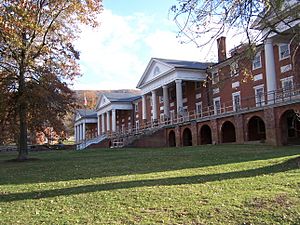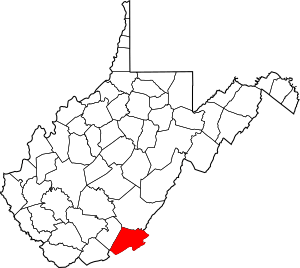Monroe County, West Virginia facts for kids
Quick facts for kids
Monroe County
|
|
|---|---|

Main Building at Sweet Springs Resort, designed by Thomas Jefferson.
|
|

Location within the U.S. state of West Virginia
|
|
 West Virginia's location within the U.S. |
|
| Country | |
| State | |
| Founded | January 14, 1799 |
| Named for | James Monroe |
| Seat | Union |
| Largest town | Peterstown |
| Area | |
| • Total | 474 sq mi (1,230 km2) |
| • Land | 473 sq mi (1,230 km2) |
| • Water | 0.9 sq mi (2 km2) 0.2%% |
| Population
(2020)
|
|
| • Total | 12,376 |
| • Density | 26.11/sq mi (10.08/km2) |
| Time zone | UTC−5 (Eastern) |
| • Summer (DST) | UTC−4 (EDT) |
| Congressional district | 3rd |
Monroe County is a county in the U.S. state of West Virginia. As of the 2020 census, the population was 12,376. Its county seat is Union.
Monroe County was the home of Andrew Summers Rowan of Spanish–American War fame, who is immortalized in Elbert Hubbard's classic A Message to Garcia. The county was also the site of the 1928 discovery of the 34.48 carat (6.896 g) Jones Diamond by Grover C. Jones and William "Punch" Jones.
Monroe County celebrates its own holiday, Farmers' Day, and is known for its close community.
Contents
History
Monroe County was formed on January 14, 1799 from portions of Greenbrier County. It was named after James Monroe, a Virginia statesman and senator, and the future fifth President of the United States.
Geography
According to the U.S. Census Bureau, the county has a total area of 474 square miles (1,230 km2), of which 473 square miles (1,230 km2) is land and 0.9 square miles (2.3 km2) (0.2%) is water.
Major highways
 U.S. Highway 219
U.S. Highway 219 West Virginia Route 3
West Virginia Route 3 West Virginia Route 12
West Virginia Route 12 West Virginia Route 122
West Virginia Route 122 West Virginia Route 311
West Virginia Route 311
Adjacent counties
- Greenbrier County (north)
- Alleghany County, Virginia (northeast)
- Craig County, Virginia (east)
- Giles County, Virginia (south)
- Summers County (west)
Watersheds
Tributaries of the James River, part of the Chesapeake Bay
Tributaries of the New River
Tributaries of the Greenbrier River
- Second Creek
- Sinks Grove
National Natural Landmark
- Greenville Saltpeter Cave
National protected areas
- George Washington National Forest
- Jefferson National Forest
Demographics
| Historical population | |||
|---|---|---|---|
| Census | Pop. | %± | |
| 1800 | 4,188 | — | |
| 1810 | 5,444 | 30.0% | |
| 1820 | 6,620 | 21.6% | |
| 1830 | 7,798 | 17.8% | |
| 1840 | 8,422 | 8.0% | |
| 1850 | 10,204 | 21.2% | |
| 1860 | 10,757 | 5.4% | |
| 1870 | 11,124 | 3.4% | |
| 1880 | 11,501 | 3.4% | |
| 1890 | 12,429 | 8.1% | |
| 1900 | 13,130 | 5.6% | |
| 1910 | 13,055 | −0.6% | |
| 1920 | 13,141 | 0.7% | |
| 1930 | 11,949 | −9.1% | |
| 1940 | 13,577 | 13.6% | |
| 1950 | 13,123 | −3.3% | |
| 1960 | 11,584 | −11.7% | |
| 1970 | 11,272 | −2.7% | |
| 1980 | 12,873 | 14.2% | |
| 1990 | 12,406 | −3.6% | |
| 2000 | 14,583 | 17.5% | |
| 2010 | 13,502 | −7.4% | |
| 2019 (est.) | 13,275 | −1.7% | |
| US Decennial Census 1790–1960 1900–1990 1990–2000 2010–2019 |
|||
2010 census
As of the 2010 United States Census, there were 13,502 people, 5,655 households, and 3,915 families in the county. The population density was 28.5/sqmi (11.0/km2). There were 7,601 housing units at an average density of 16.1/sqmi (6.20/km2). The racial makeup of the county was 97.5% white, 0.7% black or African American, 0.2% American Indian, 0.1% Asian, 0.2% from other races, and 1.3% from two or more races. Those of Hispanic or Latino origin made up 0.6% of the population. In terms of ancestry, 19.5% were Irish, 16.7% were English, 16.3% were German, 10.4% were American, and 5.7% were Scotch-Irish.
Of the 5,655 households, 27.4% had children under the age of 18 living with them, 55.7% were married couples living together, 9.3% had a female householder with no husband present, 30.8% were non-families, and 26.9% of all households were made up of individuals. The average household size was 2.38 and the average family size was 2.85. The median age was 45.0 years.
The median income for a household in the county was $39,574 and the median income for a family was $45,106. Males had a median income of $35,709 versus $23,782 for females. The per capita income for the county was $18,927. About 10.3% of families and 13.3% of the population were below the poverty line, including 18.1% of those under age 18 and 5.4% of those age 65 or over.
Natural Landmarks
One of Monroe County's geological features is Haynes Cave, a former saltpeter mine. Strange bones were discovered by the miners at the end of the 18th Century, and mailed to Thomas Jefferson. Jefferson's study of the animal, the Megalonyx jeffersonii was arguably the birth of American paleontology. It is now the official West Virginia state fossil.
However, other saltpeter caves are in private ownership and limited for tourism due to ecological risks. One such is the Greenville Saltpeter Cave, designated a national natural landmark in 1973, and very important during the War of 1812.
Historic Landmarks
- Indian Creek Covered Bridge
- Rehoboth Church
- Laurel Creek Covered Bridge
Farmers' Day
Farmers' Day is held every year on the first Saturday in June in Union. Founder Louie H. Peters, held in honor of the countless farming families in the surrounding area, the event is stretched out over the entire weekend, including the Friday evening dance held in the local grocery store's parking lot, the Pancake Breakfast and Farmers' Day Parade on Saturday, and the numerous shows, games, and activities that take place well into Sunday evening.
Fresh food produced by the citizens of Monroe County, is sold along the sidewalks, games for children can be found in the various parking lots, and live music by one of the local bands is played throughout the weekend. Popular events include the annual horse show, car show, and fire works.
Communities
Towns
- Alderson (partially)
- Peterstown
- Union (county seat)
Unincorporated communities
- Ballard
- Ballengee
- Bozoo
- Cashmere
- Cloverdale
- Crimson Springs
- Elmhurst
- Gap Mills
- Gates
- Glace
- Greenville
- Hillsdale
- Hollywood
- Keenan
- Knobs
- Laurel Branch
- Lillydale
- Lindside
- Monitor
- Pickaway
- Raines Corner
- Red Sulphur Springs
- Rock Camp
- Salt Sulphur Springs
- Sarton
- Secondcreek
- Sinks Grove
- Sweet Springs
- Waiteville
- Wayside
- Wikel
- Wolfcreek
- Zenith
Education
Monroe County Schools operates public schools:
- James Monroe High School
- Mountain View Elementary/Middle School
- Peterstown Middle School
- Peterstown Elementary School
See also
 In Spanish: Condado de Monroe (Virginia Occidental) para niños
In Spanish: Condado de Monroe (Virginia Occidental) para niños

